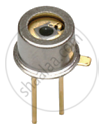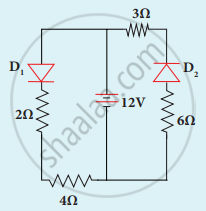Advertisements
Advertisements
प्रश्न
Write notes on the photodiode.
उत्तर

Circuit symbol

Schematic view of photodiode
- Photodiode is a p-n junction diode that converts an optical signal into electric current.
- It works in reverse bias.
- It consists of an F p-n junction semiconductor made of photosensitive material kept safely inside a plastic case.
- It has a small transparent window to allow light.
- When photon (hv) strikes depletion region of diode some valence band electrons elevated to conduction band. In turn, holes are developed in the valence band. This creates electron-hole pair.
- Amount of electron-hole pairs generated depends on the intensity of light.
- These electrons and holes swept across the junction by the electric field. Thus holes move to the n side, electrons to the p side.
- When an external circuit is made, electrons flow through an external circuit and constitute the photocurrent.
Applications:
Alarm system, count items in the conveyer belt, photoconductors, CD players, smoke detectors, detectors for computed tomography, etc.
APPEARS IN
संबंधित प्रश्न
The barrier potential of a silicon diode is approximately, ____________.
What do you mean by leakage current in a diode?
Write a short note on diffusion current across the p-n junction.
Mention the types of biasing.
List the applications of light emitting diode.
Explain the construction and working of a full-wave rectifier.
Explain the formation of depletion region and barrier potential in PN junction diode.
Explain the working principle of a solar cell. Mention its applications.
The given circuit has two ideal diodes connected as shown in the figure below. Calculate the current flowing through the resistance R1.

Determine the current flowing through 3 Ω and 4 Ω resistors of the circuit given below. Assume that diodes D1 and D2 are ideal diodes.

